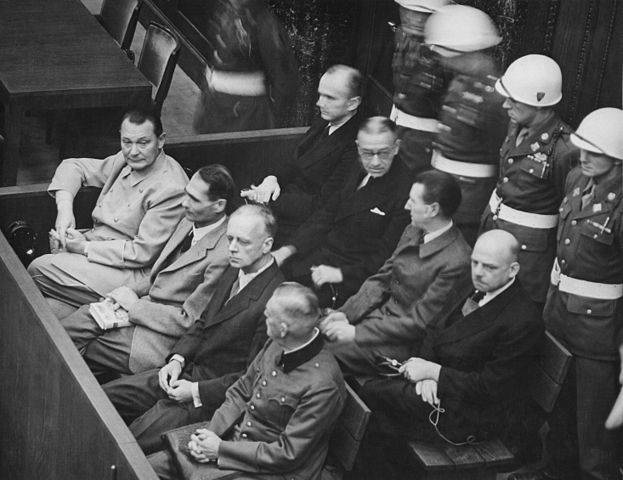[This was updated from 2023 with updated sources and information]

(in front row, from left to right): Hermann Göring, Rudolf Heß, Joachim von Ribbentrop, Wilhelm Keitel
(in second row, from left to right): Karl Dönitz, Erich Raeder, Baldur von Schirach, Fritz Sauckel)
Public Domain (Wikipedia)
In the aftermath of World War II, there was debate about how to hold accountable those responsible for war crimes and especially the Holocaust. Adolf Hitler, Heinrich Himmler and Joseph Goebbels were already dead by suicide. Churchill had the simplest approach of wanting to simply execute them, but it was decided that tribunal would be a better method. The tribunal would reveal to the world the extent of the crimes upon humanity the persons were responsible for.
The concept of an international tribunal was novel and had never been done before. Then again, no nation had before committed to full scale extermination of whole peoples as the Nazi’s had tried to do. An international tribunal composed of representatives from Great Britain, France, the Soviet Union, and the United States was formed. Defendants faced charges that varied from war crimes to crimes against humanity. Twenty- four were indicted along with six Nazi organizations such as the Gestapo that were also determined to be criminal. One was declared medically unfit to stand trial and another committed suicide before the trial began. Two top Hitler associates, Heinrich Himmler (1900-45) and Joseph Goebbels (1897-45), had each committed suicide in the spring of 1945 before they could be brought to trial.
Each defendant was allowed to choose their own lawyers. They all pled not guilty and either argued that the crimes they committed were declared crimes after the London Charter (meaning ex post facto) or that they were applying harsh standards as they were the victors. The trials would last 1 October 1946 when verdicts were handed down. Twelve were sentenced to death and others got prison terms. On 16 October 1946, 10 Nazi policy architects were hanged. Hermann Goering, who had been called the “leading war aggressor and creator of the oppressive program against the Jews,” committed suicide by poison the night before. Martin Bormann was tried in absentia and many thought he had escaped Germany. However, he never left Berlin, and his remains were eventually found (it appears he committed suicide), examined, and conclusively identified in 1988 using DNA. Other war criminals (German and Axis government leaders both civilian and military) would be tried into the 1950’s. 5,025 were convicted and 806 were executed. Those not sentenced to death, depending on what they did, served life sentences or were given shorter sentences.
Sources
———. “Nürnberg Trials | Facts, Definition, & Prominent Defendants.” Encyclopedia Britannica. Last modified November 19, 2024. https://www.britannica.com/event/Nurnberg-trials.
———. “Nuremberg Trials Begin.” HISTORY, November 19, 2024. https://www.history.com/this-day-in-history/nuremberg-trials-begin.
“The Nuremberg Trials.” https://encyclopedia.ushmm.org/content/en/article/the-nuremberg-trials.
“The Nuremberg Trials | the National WWII Museum | New Orleans.” The National WWII Museum | New Orleans. https://www.nationalww2museum.org/war/topics/nuremberg-trials.
Zapata, Christian. “Nuremberg Trials – Definition, Dates & Purpose | HISTORY.” HISTORY, August 20, 2024. https://www.history.com/topics/world-war-ii/nuremberg-trials.






